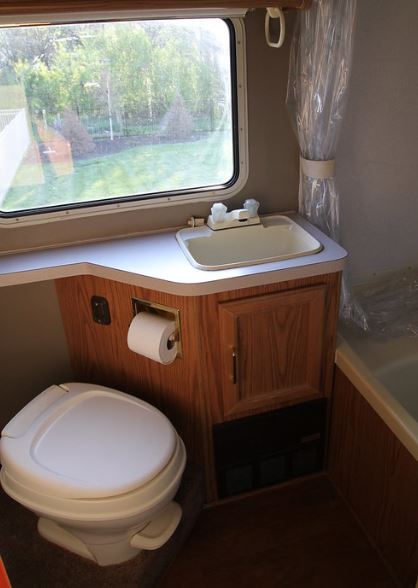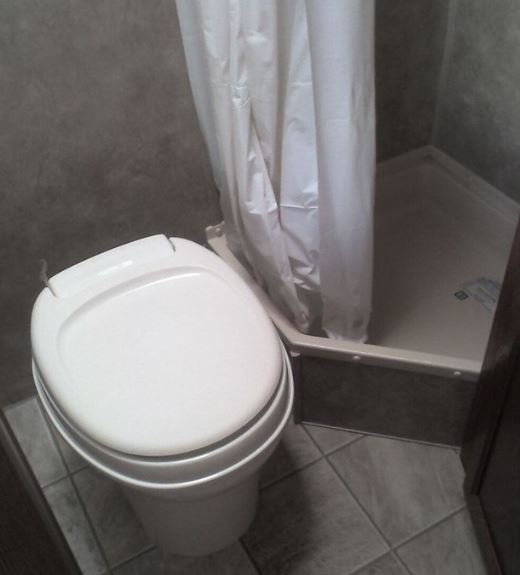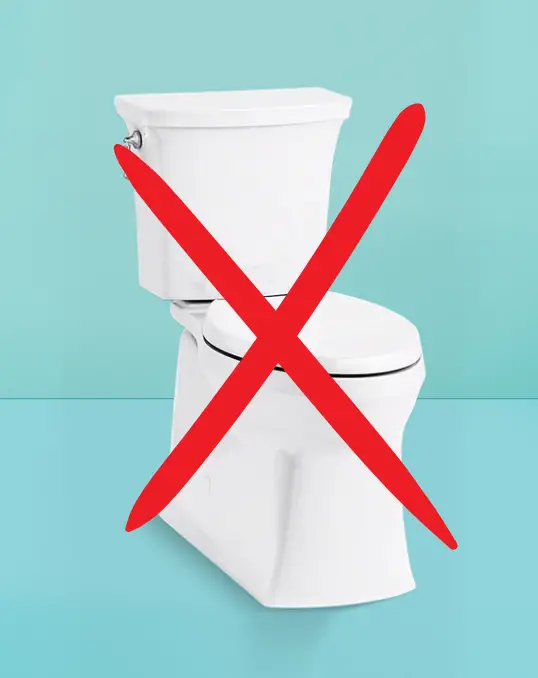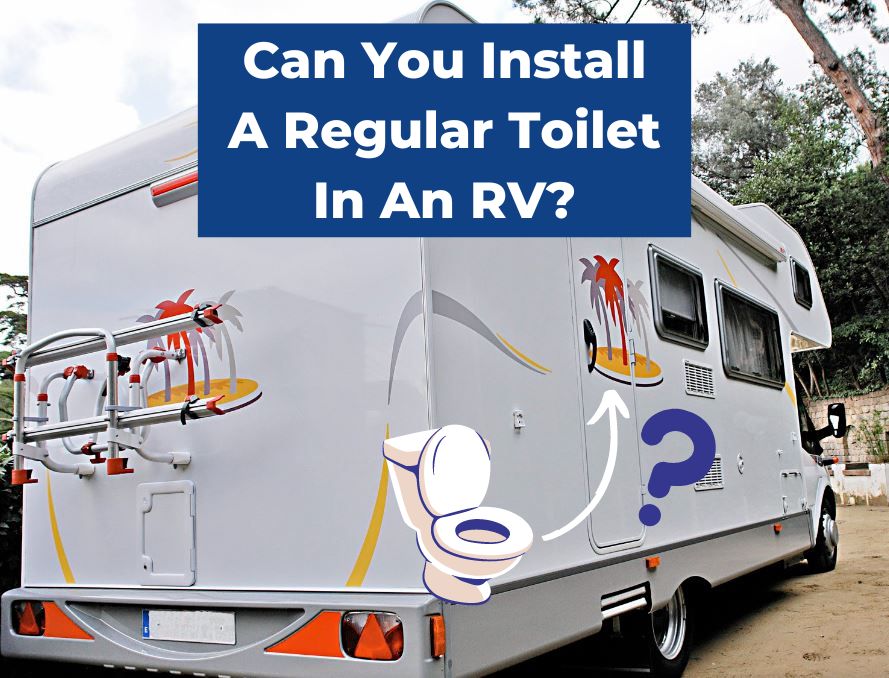RV toilets are known to have their own unique issues and sometimes you just want the comfort and familiarity of a regular toilet while away from home, which is why many RVers ask: can you install a regular toilet in an RV?
No, you cannot install a regular toilet in an RV for many reasons, including water usage, the flushing mechanism, cost, weight, and the fact that a house toilet can’t handle the movement in an RV.
We’ll explain the further details of why you can’t put a house toilet in an RV in today’s guide.
Can You Install a Regular Toilet in an RV?

The Basics of RV Toilets
RV toilets work differently than household toilets. They are designed to work with the RV’s plumbing systems and holding tanks.
Most RV toilets are either gravity toilets or composting toilets. Gravity toilets use gravity to move waste into the waste tank, while composting toilets use microbes to break down waste into compost.
RV toilets typically come with a black water tank for waste storage. The black water tank needs to be emptied frequently, and RV parks usually have extra water dumping stations for this purpose.
It is important to note that standard toilet water usage is not compatible with an RV’s plumbing system, so special RV toilets are necessary.
Installing a Regular Toilet in an RV
Installing a regular toilet in an RV is not recommended. Regular toilets are made of porcelain, which makes them heavier and harder to install securely in an RV.
They also require more water per flush, which is not compatible with the RV’s plumbing system. However, under some circumstances, it is possible to retrofit a regular toilet seat to the toilet in your RV.
The location of the hinges and size of the bathroom may make this impossible. In some cases, the RV toilet design requires a special toilet seat for the toilet to function properly.
It is important to note that installing a regular toilet in an RV may also affect the weight distribution of the RV, which can be dangerous while driving.
Replacing an RV Toilet with a Regular Toilet
Unfortunately, it is not possible to replace an RV toilet with a regular household toilet. The amount of water per flush and spatial needs of a standard toilet are not compatible with an RV’s plumbing system and holding tank.
RV toilets are designed to work with the RV’s holding tank and waste disposal system, and a regular toilet would not function properly in this system.
In conclusion, while it may be possible to retrofit a regular toilet seat to an RV toilet, it is not recommended to install a regular toilet in an RV. RV toilets are designed to work with the RV’s plumbing and waste disposal systems, and replacing them with a regular toilet can cause problems with weight distribution, plumbing, and waste disposal.
It is always best to consult with a professional before making any changes to an RV’s toilet system.
Types of RV Toilets
Foot Pedal Flushing Toilet

Foot pedal flushing toilets are the most common type of toilets in an RV. They are similar to home toilets in terms of operation, but they use less water per flush.
The foot pedal is used to control the water flow to the toilet bowl. Pressing the pedal down opens a valve and releases water into the bowl.
Releasing the pedal closes the valve and stops the water flow. These toilets work by using the RV’s water pump to provide water to the toilet bowl.
The waste is stored in a holding tank, which needs to be emptied periodically at an extra water dumping station or RV parks.
See more: How to repair your RV toilet foot pedal
Gravity Toilets
Gravity toilets are a simple and inexpensive option for RVs. They work by using gravity to move waste from the toilet bowl to the waste tank.
The toilet bowl is located above the waste tank, and a valve controls the flow of waste into the tank. These toilets do not require a water pump to function just like cassette toilets, which makes them a good option for RVs with limited water supply.
However, they do require a waste tank, which needs to be emptied periodically at an extra water dumping station or RV parks.
Related: How to clear an RV holding tank blockage
Composting Toilets
Composting toilets are becoming more popular among RVers who are looking for a more sustainable and eco-friendly option. These toilets work by separating liquids from solids and using natural processes to compost the waste.
They do not require a water supply or a waste tank, which makes them a good option for off-grid RVs. However, they do require regular maintenance and monitoring to ensure proper composting.
Composting toilets can be more expensive than other types of RV toilets, but they can save water and reduce the need for frequent waste tank emptying.
RV Plumbing Systems
When it comes to RVs, one of the most important systems is the plumbing system. Without it, you wouldn’t be able to use the bathroom, shower, or even wash your hands. Understanding how RV plumbing systems work is crucial for any RV owner, especially when considering installing a regular toilet.
Understanding RV Plumbing Systems
RV plumbing systems are similar to household plumbing systems, but with some key differences. Instead of being connected to a city’s water supply and sewer system, RVs have their own water and waste tanks.
These tanks are filled and emptied using hoses and pumps and have special considerations like using special RV toilet paper.
Waste Tanks
One of the most important parts of an RV plumbing system is the waste tank. This is where all the waste from the toilet, sinks, and shower are stored until they can be emptied. There are two types of waste tanks: gray water tanks and black water tanks.
Black Water Tanks
Black water tanks are specifically designed to hold waste from the toilet. They are usually larger than gray water tanks and require more maintenance. RV parks and campgrounds have designated dumping stations where you can empty your black water tank.
Holding Tanks
Holding tanks are another important part of an RV plumbing system. They are used to store fresh water and waste water until they can be emptied. Holding tanks come in different sizes, depending on the size of the RV and the number of people using it.
Extra Water Dumping Station
Some RVs come with an extra water dumping station, which allows you to empty your holding tanks without having to move your RV to a dumping station. This is especially useful if you’re camping in a remote location.
Water Pump
The water pump is what moves water from the holding tank to the faucets and shower. It’s important to make sure that the water pump is working properly, as it can affect the water pressure and flow.
Overall, RV plumbing systems are complex but essential to the functionality of an RV. While it may be tempting to replace an RV toilet with a household toilet, it’s important to consider the compatibility of the toilet with the RV’s plumbing system. Composting toilets and gravity toilets are more compatible with RVs than standard household toilets, which have higher water usage and are harder to install.
Why You Shouldn’t Install A Regular Toilet In An RV

Standard Toilet Water Usage in an RV
Installing a regular toilet in an RV is not recommended due to the high amount of standard toilet water usage. RVs have limited water supply, and installing a regular toilet can quickly deplete the water.
A standard toilet uses around 1.6 gallons of water per flush, while an RV toilet uses only around 0.5 gallons. This means that a regular toilet can cause problems with water supply and lead to extra water dumping station visits.
Regular Toilets Weigh More
Another reason why you shouldn’t install a regular toilet in an RV is that they weigh more than RV toilets. RVs are designed to be lightweight, and adding a regular toilet can increase the weight significantly. This can cause problems with the RV’s plumbing systems and the water pump, leading to frequent repairs and maintenance.
They Won’t Keep Bad Smells Out
Standard household toilets don’t have the same closing mechanisms as RV toilets. Simply put, a regular toilet is going to let the unpleasant odors from your black tank out into your camper, which you absolutely do not want happening.
Regular Toilets Can’t Handle RV Road Travel
RVs are designed to be mobile, and regular toilets are not designed to handle the vibrations and movements of an RV in motion.
Regular toilets can become loose or even break during travel, leading to costly repairs and replacements. RV toilets, on the other hand, are designed to withstand the rigors of road travel.
Standard Toilets Take Up More Space
RVs have limited space, and installing a regular toilet can take up valuable space that could be used for other purposes. RV toilets are designed to be compact and take up minimal space, while regular toilets are larger and require more room.
They’re More Expensive To Install
Replacing an RV toilet with a household toilet can be expensive, as it requires additional plumbing and modifications. RV toilets are designed to work with holding tanks, while regular toilets require a connection to a septic system or sewer line, which may not be available at RV parks or campsites.
This can lead to additional expenses, such as installing a waste tank or connecting to a sewer line.
Overall, installing a regular toilet in an RV is not recommended due to the reasons mentioned above. RV toilets are designed to be lightweight, compact, and efficient, and they work well with RV plumbing systems.At the end of it all, regular toilets may be more comfortable, but they are not suitable for use in an RV.

